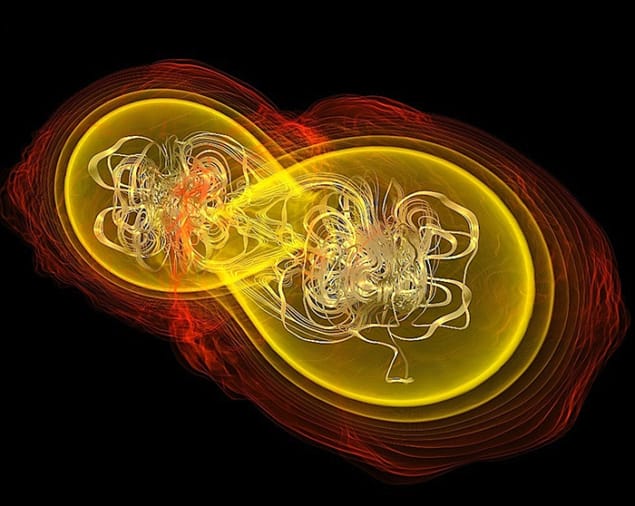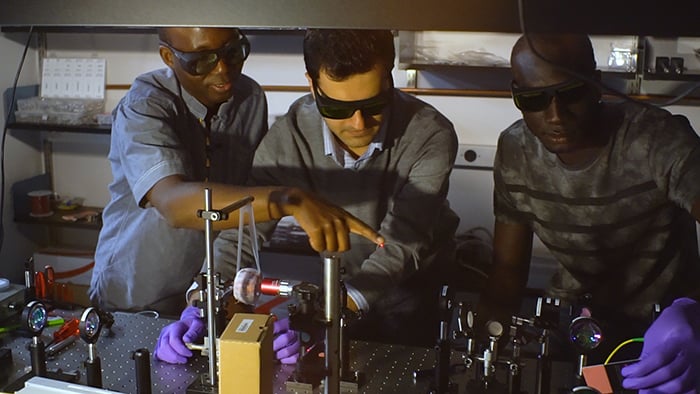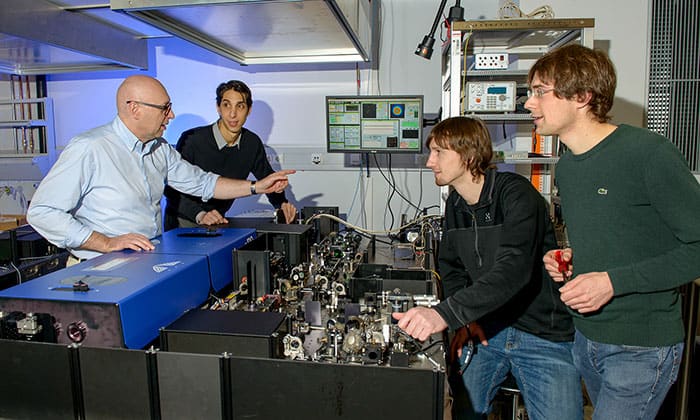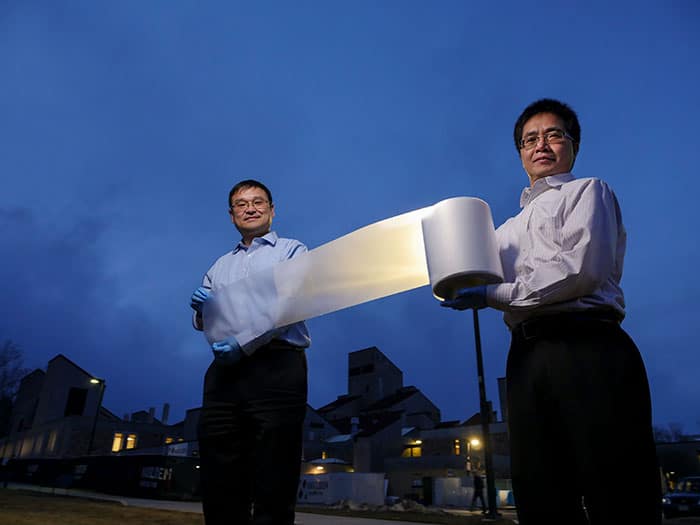The Physics World 2017 Breakthrough of the Year goes to the international team of astronomers and astrophysicists that ushered in a new era of astronomy by making the first ever multimessenger observation involving gravitational waves. Nine other achievements are highly commended and cover topics ranging from topological physics to Egyptology and more.

On 17 August 2017 the LIGO–Virgo gravitational-wave detectors, the Fermi Gamma-ray Space Telescope and the INTEGRAL gamma-ray space telescope detected nearly-simultaneous signals. They came from the merger of two neutron stars – an object now called GW 170817. This was the first time that LIGO–Virgo scientists had seen a neutron star merger, but five hours later they had already worked out the location of the source in the sky. Over the next hours and days, more than 70 telescopes were pointed at GW 170817 and a wealth of observations were made in the gamma-ray, X-ray, visible, infrared and radio portions of the electromagnetic spectrum. Astrophysicists also searched for neutrinos, but none were seen.
These coordinated observations have already provided a vast amount of information about what happens when neutron stars collide in what is called a “kilonova”. The observations have yielded important clues about how heavy elements, such as gold, are produced in the universe. The ability to measure both gravitational waves and visible light from neutron-star mergers has also given a new and independent way of measuring the expansion rate of the universe. In addition, the observation settles a long-standing debate about the origin of short, high-energy, gamma-ray bursts.
Epitome of collaboration
This year’s award has been given to thousands of scientists working in nearly 50 collaborations worldwide. While some awards, notably the Nobel prizes, are given to individuals and not groups, here at Physics World we recognize that science is a collaborative effort. Furthermore, we believe that the multimessenger observation of GW 170817 epitomizes the collaborative nature of science and is a shining example of how our knowledge of the universe can move forwards when people from all over the world join together with a common scientific cause.
A comprehensive description of the multimessenger observation and a full list of all the scientists and collaborations involved can be found in The Astrophysical Journal Letters.
The podcast “Exploring the cosmos with gravitational waves” features interviews with several of the scientists who took part in the award-winning observations.
For a more in-depth look at the significance of these latest discoveries, take a look at the ebook Multimessenger Astronomy, which is free to read.
The Physics World top 10 breakthroughs of 2017 are awarded to research reported on physicworld.com in 2017. The 10 breakthroughs are chosen by Physics World editors from a shortlist based on popularity with our readers. The criteria for judging included:
- fundamental importance of research;
- significant advance in knowledge;
- strong connection between theory and experiment; and
- general interest to all physicists.
Now for our nine runner-up breakthroughs, which are listed below in no particular order.
Physicists create first ‘topological’ laser

To Boubacar Kanté and colleagues at the University of California, San Diego, for creating the first “topological laser”. The device involves light snaking around a cavity of any shape without scattering – much like the motion of electrons on the surface of a topological insulator. The laser works at telecom wavelengths and could lead to better photonic circuits or even protect quantum information from scattering.
Lightning makes radioactive isotopes
To Teruaki Enoto of Kyoto University and colleagues for providing the first detailed, convincing evidence that lightning strikes can lead to the synthesis of radioactive isotopes in the atmosphere. Physicists already knew that lightning strikes can produce gamma rays and neutrons, and had suspected that interactions between this radiation and nitrogen nuclei in the air could create radioactive nuclei. Enoto and colleagues confirmed this by measuring a gamma-ray signal indicative of nuclear decay that peaked about 1 min after a lightning strike. This, they say, is evidence for the production of radioactive nuclei such as nitrogen-13.
Super-resolution microscope combines Nobel-winning technologies

To Francisco Balzarotti, Yvan Eilers, Klaus Gwosch, Stefan Hell and colleagues at the Max Planck Institute for Biophysical Chemistry, Uppsala University and the University of Buenos Aires, for developing a new type of super-resolution microscope that can track biological molecules in living cells in real time. The new technique is called maximally informative luminescence excitation probing (MINFLUX) and it combines the merits of two Nobel-prize-winning techniques – one of which was developed by Hell. MINFLUX attains nanometre-scale resolution more quickly and with fewer emitted photons than previously possible.
Particle-free quantum communication is achieved in the lab
To Hatim Salih of the University of Bristol and colleagues and Jian-Wei Pan of the University of Science and Technology of China and colleagues for the theory and experimental realization of transmitting information using quantum physics without the exchange of any particles. Four years ago, Salih and colleagues proposed a new quantum-communication scheme that does not require the transmission of any physical particles. While some physicists were sceptical, this year a team led by Pan created such a system in the lab and used it to transfer a simple image while sending (almost) no photons in the process. Dubbed “counterfactual imaging”, the technique could prove handy in imaging delicate pieces of ancient art that cannot be exposed to direct light.
Ultra-high-energy cosmic rays have extra-galactic origins

To the Pierre Auger Observatory collaboration for showing that ultra-high-energy cosmic rays come from outside the Milky Way. For decades, astrophysicists have believed that the sources of cosmic rays with energies greater than about 1 EeV (1018 eV) could be worked out from the arrival directions of these particles. This is unlike lower energy cosmic rays, which appear to come from all directions after being deflected by the Milky Way’s magnetic fields. Now, Pierre Auger’s 1600 Cherenkov particle detectors in Argentina have revealed that the arrival rate of ultra-high-energy cosmic rays is greater in one half of the sky. What is more, the excess lies away from the centre of the Milky Way – suggesting that the cosmic rays have extra-galactic origins.
‘Time crystals’ built in the lab
To Christopher Monroe at the University of Maryland and colleagues and Mikhail Lukin of Harvard University and colleagues for their independent creation of “time crystals”. Like conventional crystals, which spontaneously break translational symmetry, time crystals spontaneously break discrete time symmetry. Time crystals were first predicted five years ago and now two spin-based systems with properties resembling time crystals have been created. Lukin used spins in diamond defects, while Monroe’s spins were trapped ions.
Metamaterial enhances natural cooling without power input

To Ronggui Yang and Xiaobo Yin of the University of Colorado Boulder and colleagues for creating a new metamaterial film that provides cooling without the need for a power source. Made out of glass microspheres, polymer and silver, the material uses passive radiative cooling to dissipate heat from the object that it covers. It emits the energy as infrared radiation, so it can travel through the atmosphere and ultimately into space. The material also reflects sunlight, which means that it works both day and night. But perhaps most importantly, it can be produced cheaply at an industrial scale.
Three-photon interference measured at long last
To Sascha Agne and Thomas Jennewein of the University of Waterloo and colleagues and Stefanie Barz, Steve Kolthammer and Ian Walmsley of the University of Oxford and colleagues for independently measuring quantum interference involving three photons. Seeing the effect is very difficult because it requires the ability to deliver three indistinguishable photons to the same place at the same time and also to ensure that single-photon and two-photon interference effects are eliminated from the measurements. As well as providing deep insights into the fundamentals of quantum mechanics, three-photon interference could also be used in quantum cryptography and quantum simulators.
Muons reveal hidden void in Egyptian pyramid

To the ScanPyramids collaboration for using cosmic-ray muons to find evidence for a hitherto unknown large void in Khufu’s Pyramid at Giza, Egypt. By placing different types of muon detectors in and around the pyramid, the team measured how showers of muons were attenuated as they passed through the huge structure. Computer algorithms analysed the data and revealed an unexpected and very large void deep within the pyramid.



